 W
WAenigmastropheus is an extinct genus of early archosauromorph reptiles known from the middle Late Permian Usili Formation of Songea District, southern Tanzania. It contains a single species, Aenigmastropheus parringtoni, known solely from UMZC T836, a partial postcranial skeleton of a mature individual. It was collected in 1933, and first described in 1956, as a "problematic reptile" due to its unique morphology. Therefore, a binomial name was erected for this specimen in 2014. Aenigmastropheus was probably fully terrestrial.
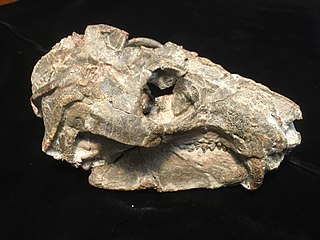 W
WAleodon is an extinct genus of cynodonts that lived from the Middle to the Late Triassic. Relatively few analyses have been conducted to identify the phylogenetic placement of Aleodon, however those that have place Aleodon as a sister taxon to Chiniquodon. Two species of Aleodon are recognized: A. brachyramphus which was discovered in Tanzania, and A. cromptoni which was discovered most recently in Brazil.
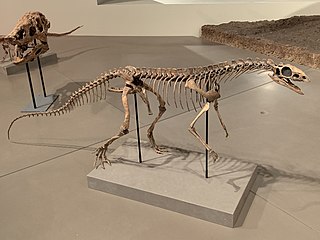 W
WAsilisaurus ( ah-SEE-lee-SOR-əs; from Swahili, asili, and Greek, σαυρος is an extinct genus of silesaurid archosaur. The type species is Asilisaurus kongwe. Asilisaurus fossils were uncovered in the Manda Beds of Tanzania and date back to the Anisian stage of the Middle Triassic, making it one of the oldest known members of the Avemetatarsalia. It was the first non-dinosaurian dinosauriform recovered from Africa.The discovery of Asilisaurus has provided evidence for a rapid diversification of avemetatarsalians during the Middle Triassic, with the diversification of archosaurs during this time previously only documented in pseudosuchians.
 W
WAsperoris is an extinct genus of archosauriform reptile known from the Middle Triassic Manda Beds of southwestern Tanzania. It is the first archosauriform known from the Manda Beds that is not an archosaur. However, its relationships with other non-archosaurian archosauriforms are uncertain. It was first named by Sterling J. Nesbitt, Richard J. Butler and David J. Gower in 2013 and the type species is Asperoris mnyama. Asperoris means "rough face" in Latin, referring to the distinctive rough texture of its skull bones.
 W
WAustralodocus is a genus of sauropod dinosaur that lived during the Late Jurassic period, around 150 million years ago, in what is now Tanzania. Though initially considered a diplodocid, recent analyses suggest it may instead be a titanosauriform.
 W
WCeratosaurus was a carnivorous theropod dinosaur in the Late Jurassic period. This genus was first described in 1884 by American paleontologist Othniel Charles Marsh based on a nearly complete skeleton discovered in Garden Park, Colorado, in rocks belonging to the Morrison Formation. The type species is Ceratosaurus nasicornis.
 W
WCricodon is an extinct genus of trirachodontid cynodonts that lived during the Early Triassic and Middle Triassic periods of Africa. A. W. Crompton named Cricodon based on the ring-like arrangement of the cuspules on the crown of a typical postcanine tooth. The epithet of the type species, C. metabolus, indicates the change in structure of certain postcanines resulting from replacement.
 W
WCynognathus is an extinct genus of large-bodied cynodontian therapsids that lived in the Middle Triassic. It is known from a single species, Cynognathus crateronotus. Cynognathus was a 1.2-metre long predator closely related to mammals and had a southern hemispheric distribution. Fossils have so far been recovered from South Africa, Argentina, Antarctica, and Namibia.
 W
WDiademodon is an extinct genus of cynodonts. It was about 2 metres (6.6 ft) long. Although Diademodon is the most well accepted name for the genera to date, it was originally named Cynochampsa laniarius by Owen in 1860. The proposed name change occurred in 1982, where Grine defended the name proposed by Harry Seeley: Diademodon tetragonus and to be place in the group Therapsida, which was a group Owen had tiptoed around in his works on paleontology. Though Harry Govier Seeley had named Diademodon in 1894, which was after Owen had dubbed the genus Cynochampsa, Seeley had not realized the two were one and the same as the fossil that Owen named was claimed to have been found in a claystone nodule in the Renosterberg Mountains. A later paleontologist explored the same area where the fossil was claimed to have been found and declared no evidence of Cynognathus fossils.
 W
WDicynodontoides is a genus of small to medium-bodied, herbivorous, emydopoid dicynodonts from the Late Permian. The name Dicynodontoides references its “dicynodont-like” appearance due to the caniniform tusks featured by most members of this infraorder. Kingoria, a junior synonym, has been used more widely in the literature than the more obscure Dicynodontoides, which is similar-sounding to another distantly related genus of dicynodont, Dicynodon. Two species are recognized: D. recurvidens from South Africa, and D. nowacki from Tanzania.
 W
WDinogorgon is a genus of gorgonopsid from the Late Permian of South Africa and Tanzania. The generic name Dinogorgon is derived from Greek, meaning "terrible gorgon", while its species name rubidgei is taken from the surname of renowned Karoo paleontologist, Professor Bruce Rubidge, who has contributed to much of the research conducted on therapsids of the Karoo Basin. The type species of the genus is D. rubidgei.
 W
WElaphrosaurus is a genus of ceratosaurian theropod dinosaur that lived approximately 154 to 150 million years ago during the later part of the Jurassic Period in what is now Tanzania in Africa. Elaphrosaurus was a medium-sized but lightly built member of the group that could grow up to 6.2 m (20 ft) long. Morphologically, this dinosaur is significant in two ways. Firstly, it has a relatively long body but is very shallow-chested for a theropod of its size. Secondly, it has very short hindlimbs in comparison with its body. Phylogenetic analyses indicate that this genus is likely a ceratosaur. Earlier suggestions that it is a late surviving coelophysoid have been examined but generally dismissed. Elaphrosaurus is currently believed to be a very close relative of Limusaurus, an unusual beaked ceratosaurian which may have been either herbivorous or omnivorous.
 W
WEndothiodon is an extinct genus of large dicynodont from the Late Permian. Like other dicynodonts, Endothiodon was an herbivore, but it lacked the two tusks that characterized most other dicynodonts. The anterior portion of the upper and lower jaw are curved upward, creating a distinct beak that is thought to have allowed them to be specialized grazers.
 W
WGalulatherium is a genus of probably gondwanathere from the Late Cretaceous (Turonian-Campanian) Galula Formation of Tanzania.
 W
WGlossopteris is the largest and best-known genus of the extinct Permian order of seed ferns known as Glossopteridales. The genus Glossopteris refers only to leaves, within a framework of form genera used in paleobotany. Species of Glossopteris were widespread over the supercontinent of Gondwana during the Permian epoch, where they formed the dominant component of high latitude polar forests. Glossopteris fossils were critical in recognizing former connections between the various fragments of Gondwana: South America, Africa, India, Australia, New Zealand, and Antarctica.
 W
WHyperodapedon is a genus of rhynchosaurs from the Late Triassic period. Fossils of the genus have been found in Africa, Asia, Europe and North and South America. Its first discovery and naming was found by Thomas Henry Huxley in 1859. Hyperodapedon was a herbivore that used its beaked premaxilla and hindlimbs to dig for plants in dry land.
 W
WHypselorhachis is a genus of extinct reptile, possibly a ctenosauriscid archosaur related to Ctenosauriscus. It lived during the Triassic Period. It is currently known only from a single vertebra found from the Middle Triassic Manda Beds in Tanzania. The vertebra is preserved in reasonably good condition, as although the tall neural spine is chipped in several places it is not broken despite being quite slender, only around 20 mm thick transversely.
 W
WKannemeyeria is a genus of kannemeyeriid dicynodont that lived during the Anisian age of Middle Triassic period in what is now Africa and possibly Europe and Asia as well. The generic name is given in honor of Dr. Daniel Rossouw Kannemeyer, the South African fossil collector who discovered the original specimen. It is one of the first representatives of the family, and hence one of the first large herbivores of the Triassic.
 W
WLaetoli is a site in Tanzania, dated to the Plio-Pleistocene and famous for its hominin footprints, preserved in volcanic ash. The site of the Laetoli footprints is located 45 km south of Olduvai gorge. The location and tracks were discovered by archaeologist Mary Leakey and her team in 1976, and were excavated by 1978. Based on analysis of the footfall impressions "The Laetoli Footprints" provided convincing evidence for the theory of bipedalism in Pliocene hominins and received significant recognition by scientists and the public. Since 1998, paleontological expeditions have continued under the leadership of Amandus Kwekason of the National Museum of Tanzania and Terry Harrison of New York University, leading to the recovery of more than a dozen new hominin finds, as well as a comprehensive reconstruction of the paleoecology.
 W
WLH 4 or Laetoli Hominid 4 is the catalogue number of a fossilized mandible which was discovered by Mary Leakey in 1974 from Laetoli, Tanzania.
 W
WThe Ndutu skull is the partial cranium of a hominin that has been assigned variously to late Homo erectus Homo rhodesiensis, and early Homo sapiens, from the Middle Pleistocene, found at Lake Ndutu in northern Tanzania.
 W
WA nummulite is a large lenticular fossil, characterized by its numerous coils, subdivided by septa into chambers. They are the shells of the fossil and present-day marine protozoan Nummulites, a type of foraminiferan. Nummulites commonly vary in diameter from 1.3 cm to 5 cm and are common in Eocene to Miocene marine rocks, particularly around southwest Asia and the Mediterranean. Fossils up to six inches wide are found in the Middle Eocene rocks of Turkey. They are valuable as index fossils.
 W
WNyasasaurus is an extinct genus of dinosauriform reptile from the Middle Triassic Manda Formation of Tanzania that appears to be the earliest known dinosaur. The type species Nyasasaurus parringtoni was first described in 1956 in the doctoral thesis of English paleontologist Alan J. Charig, but it was not formally described until 2013. Previously, the oldest record of dinosaurs was from Argentina and dated back to the late Carnian stage, about 231.4 million years ago. Nyasasaurus comes from a deposit that dates back to the Anisian stage, meaning that it predates other early dinosaurs by about 12 million years.
 W
WOH 5 is a fossilized cranium and the holotype of the species Paranthropus boisei. It was discovered in Olduvai Gorge, Tanzania, by archaeologist-paleontologist Mary Leakey in 1959. Her husband and fellow scientist Louis Leakey initially classified the hominid as Zinjanthropus boisei and thought that it was an early ancestor of modern humans that lived approximately 2 million years ago. However, this contention was later withdrawn because of its robust australopithecine features and the discovery of Homo habilis soon thereafter.
 W
WOH 7, also nicknamed "Johnny's Child", is the type specimen of Homo habilis. The fossils were discovered on November 4, 1960 in Olduvai Gorge, Tanzania, by Jonathan and Mary Leakey. The remains are dated to approximately 1.75 million years, and consist of fragmented parts of a lower mandible, an isolated maxillary molar, two parietal bones, and twenty-one finger, hand, and wrist bones.
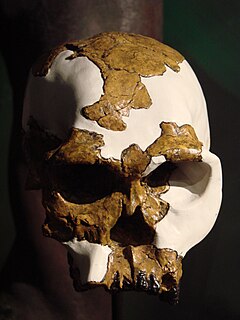 W
WOH 24 is a fossilized skull of the species Homo habilis. It was discovered in Olduvai Gorge, Tanzania by Peter Nzube in 1968. The skull was found crushed almost flat and was therefore named after the famously skinny model of the time Twiggy. Estimated at about 1.8 mya, the cranium was found crushed flat and cemented together with a mass coating of limestone.
 W
WOlduvai Hominid number 8 is a fossilized foot of an early hominin found in Olduvai Gorge by Louis Leakey in the early 1960s.
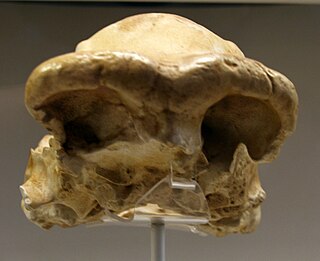 W
WOlduvai Hominid number 9 is a fossilized skull cap of an early hominin, found in LLK II, Olduvai Gorge by Louis S. B. Leakey in 1960. It is believed to be ca. 1.4 million years old. Its cranial capacity is estimated at than 1067 cm3, the largest value among all known African Homo erectus specimens. OH 9 is significant because the features it carried and its correlation to the species classification it resides in.
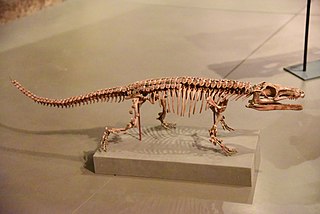 W
WParringtonia is an extinct genus of Triassic archosaur within the family Erpetosuchidae, known from the type species Parringtonia gracilis. It is known from a single specimen, NHMUK R8646, found from the Anisian-age Manda Formation of Tanzania. This specimen, like most archosaur material from the Manda Formation, is fragmentary, including only a maxilla and a few postcranial bones. They show similarities with those of another archosaur called Erpetosuchus, known from the Middle Triassic of Scotland and the eastern United States. The phylogenetic placement of Parringtonia and Erpetosuchus are uncertain; some studies placed them close to the group Crocodylomorpha, which includes all modern crocodylians and many extinct forms that diversified after the Triassic, but this relationship has more recently been questioned.
 W
WPeltobatrachus is an extinct genus of temnospondyl amphibian from the late Permian period of Tanzania.
 W
WThe Peninj Mandible(Peninj 1), also called Natron mandible, is the fossilized lower jaw and teeth of an australopithecine specimen, likely that of Australopithecus boisei or a similar population. It was discovered in West Lake Natron, in the Arusha Region of Tanzania by Kamoya Kimeu, Glynn Isaac, and Richard Leakey in 1964.
 W
WProcynosuchus is an extinct genus of cynodonts from the Late Permian. It is considered to be one of the earliest and most basal cynodonts. It was 60 cm (2 ft) long and seems to have been adapted to a semi-aquatic lifestyle.
 W
WRukwatita is a genus of titanosaur sauropod dinosaur from the Galula Formation in Tanzania. It lived around 100 million years ago, during the middle Cretaceous. The species, which shared features with another southern African species, Malawisaurus dixeyi, measured 30 feet (9.1 m) from the head to the tip of the tail, and had forelimbs that were estimated around 6.5 feet (2.0 m) long. Its fossils were found embedded in a cliff face near Lake Rukwa in the Rukwa Valley, from which it gets its name.
 W
WSauroctonus is an extinct genus of therapsids. Sauroctonus progressus was a large gorgonopsid that lived in the Late Permian epoch before the Permian-Triassic extinction event that wiped out many life forms on Earth. Its fossils have been found in the Usili Formation of Tanzania and the Sokolki Assemblage Zone of the Volga Basin of Russia.
 W
WStanocephalosaurus is an extinct genus of large-sized temnospondyl amphibians living through the early to mid Triassic. The etymology of its name most likely came from its long narrow skull when compared to other temnospondyls. Stanocephalosaurus lived an aquatic lifestyle, occpying rivers, lakes, swamps, and shores, with some species even living in salt lakes. There are currently three recognized species and another that needs further material to establish its legitimacy. The three known species are Stanocephalosaurus pronus from the Middle Triassic in Tanzania, Stanocephalosaurus amenasensis from the Lower Triassic in Algeria, and Stanocephalosaurus birdi, from the middle Triassic in Arizona. Stanocephalosaurus rajareddyi from the Middle Triassic in central India needs further evidence in order to establish its relationship among other Stanocephalosaurs. Like other temnospondyls, Stanocephalosaurus was an aquatic carnivore. Evidence of multiple species discovered in a wide range of localities proves that Stanocephalosaurus were present all across Pangea throughout the early to mid Triassic.
 W
WStenaulorhynchus is an extinct genus of hyperodapedontid rhynchosaur known from the Middle Triassic deposits of Tanganyika Territory, Tanzania. It was found in the Lifua Member of the Manda Formation in the Karoo Supergroup. It was named and first described by Sidney Henry Haughton in 1932. The type species is Stenaulorhynchus stockleyi, a beaked herbivore measuring 1–6 meters in length.
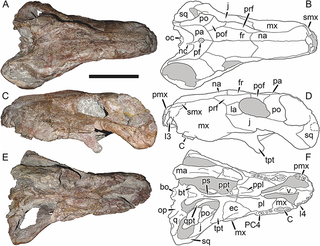 W
WSycosaurus is an extinct genus of rubidgeine gorgonopsians from the Usili Formation of Tanzania. It was medium-sized, about 1.2 m in length. It was first named by Haughton in 1924, and contains two species, S. laticeps and S. nowaki.
 W
WTetragonias is an extinct genus of non-mammalian synapsid from the Anisian Manda Beds of Tanzania. Tetra- means “four,” and goni- means “angle,” referencing the square shape of the Tetragonias skull when viewed dorsally. Not to be confused with Tetragonia, Tetragonias were dicynodont anomodonts discovered in the late 1960s by paleontologist A. R. I. Cruickshank in the Manda Formation.